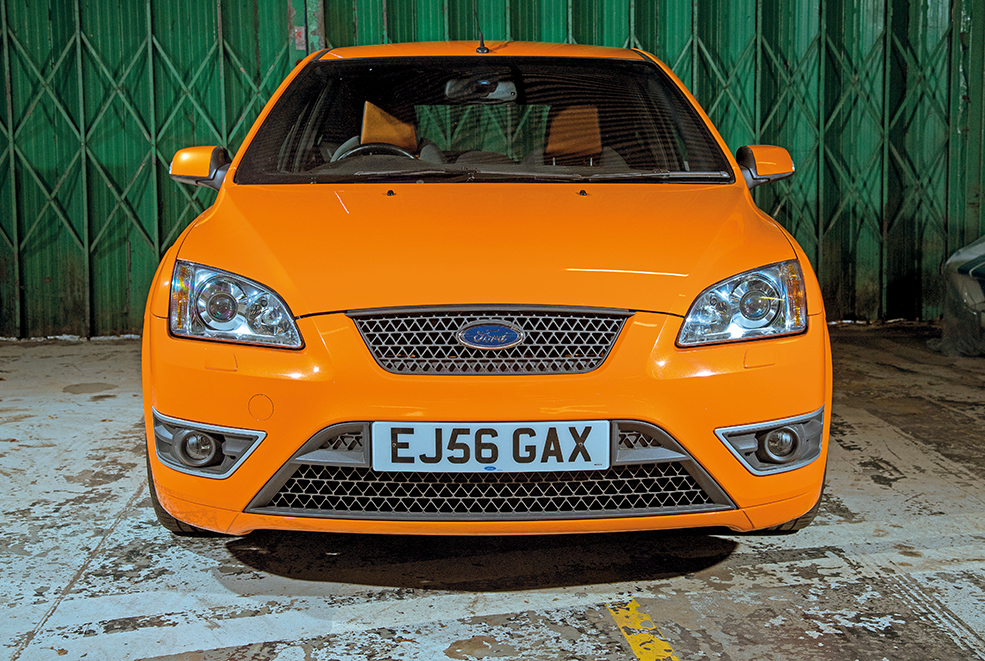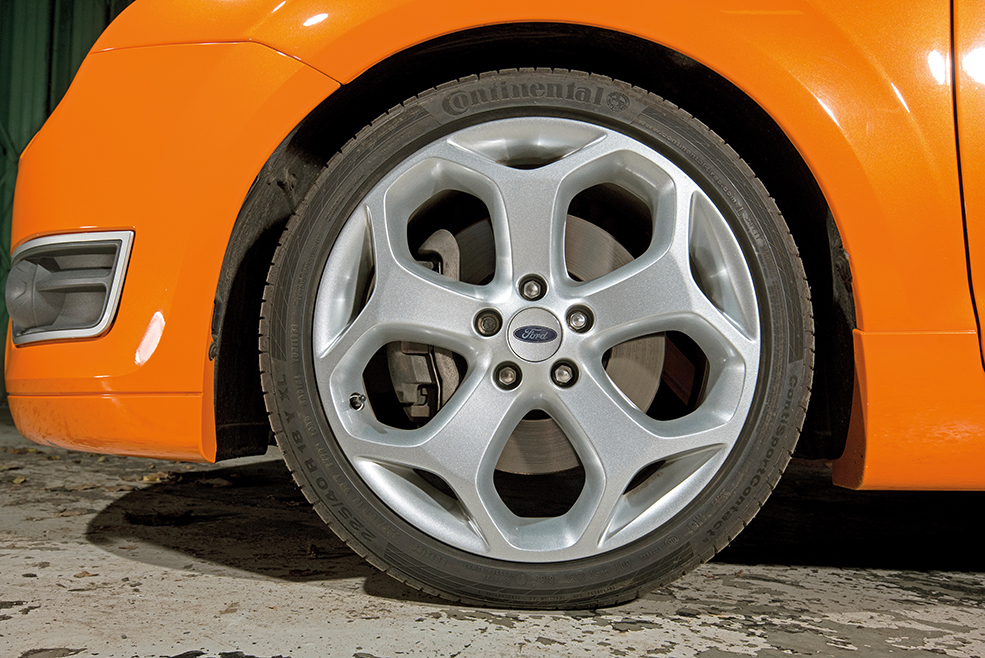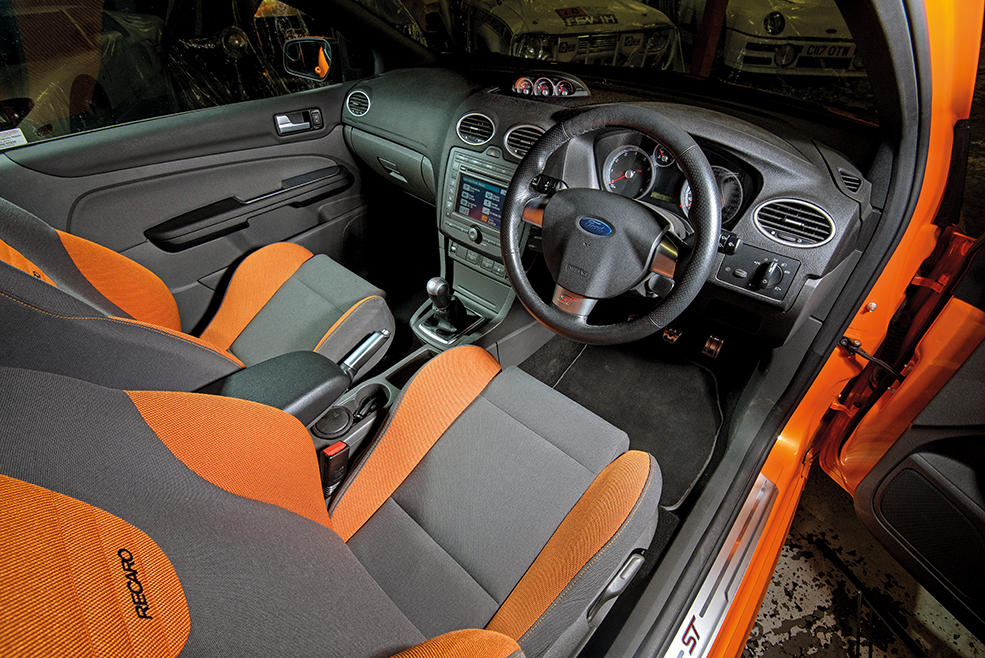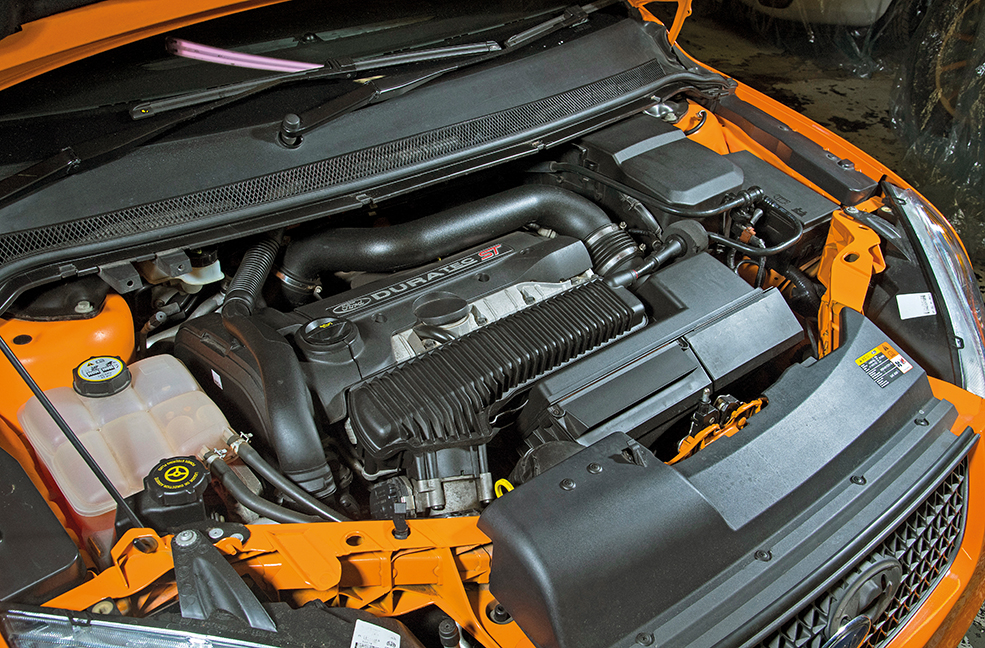Fast Fords are a part of hot hatch history, that’s a fact. The Ford Focus ST Mk2 firmly established itself as a modern performance favourite for a reasonable price tag. Here’s what you need to know before buying one plus some tuning tips. Sponsored by Adrian Flux.
We’re spoilt for horsepower these days, we really are. It wasn’t all that long ago (or so it seems) that we were squeezing incremental gains from wheezing CVHs and OHV eight-valvers to try and pick our way north of 120hp or, if the gods were smiling on us, perhaps even 130… the hot hatch game has snowballed beyond all recognition in recent years. But even during these escalating horsepower wars, with warrantied shopping hatches sailing above 300hp and rival tuners bickering about the legitimacy of bridge-to-gantry times, it’s still worth taking a step back and just marvelling at the glorious lunacy of Ford’s decision to bolt a 2.5-litre, five-cylinder engine into the Focus ST. And not only that but strapping a turbo to it as well. How brilliantly, spectacularly unnecessary was that?
The Mk2 Focus platform was a formidable base even in stock shopper-spec form; much like the Mk1 that came before it, Ford’s engineers put a huge amount of time, effort and investment into ensuring that every Focus that left the factory was a sweet little handler, so you could be guaranteed a good time even in a basic 1.4. Launched in 2004, the Mk2 used the Ford C1 platform, which was also shared with the likes of the Volvo S40 and Mazda3; it carried over the basic suspension design from the Mk1 Focus and wrapped it up in a bodyshell that was 10% stiffer, and keen attention was paid to improving the fit-and-finish, and quality of interior materials.

Ford Focus ST Mk2 history
The Ford Focus ST Mk2 launched in 2005, and it was a very effective tool in reframing people’s perceptions of hot Fords. In the old days, the XR range was the warm option and the RS cars were the really hot ones. So if we instead had ST and RS, then the same should apply, yes? Well, yes and no. The RS was still the hotter car, but there really wasn’t anything lukewarm about the Focus ST.
Indeed, it positively blew people’s minds with its use of a Volvo-derived five-cylinder 2.5-litre turbo, packing an unstressed 225hp. That’s Escort RS Cosworth power in a car that’d happily and comfortably pootle to the shops if it needed to. And of course, the modifying fraternity pounced on the thing with gusto. Race and rally developments quickly trickled down to road cars, and before you knew it every town across the UK was resonating to the gritty harmonic of 400hp Focuses with anti-lag.
Focus ST Mk2 Trim levels
The ST was available in either three- or five-door format and the spec levels available were ST, ST-2 and ST-3. ST was the base, and relatively few cars were sold in this spec as the upper levels offered such excellent value in terms of additional equipment for the slightly larger outlay. Standard equipment offered the ST-specific body kit and boot spoiler, air-conditioning, Recaro seats and front fog lamps; the ST-2 level added Xenon headlights, a heated windscreen, ESP, a single-disc Sony stereo (instead of the standard-issue Ford stereo), and more speakers; ST-3 also provided leather trim with heated front seats, a sculpted rear bench that made it a four- rather than five-seater, and a six-disc Sony stereo.
There were also a whole bunch of extras available on the options list, including a sunroof, heated cloth seats, climate control, Bluetooth connectivity, DVD sat-nav, Sony DAB, USB inputs, Global Close (which shut all the windows when you locked the car with the remote; this also equipped five-door models with electric rear windows), the Light and Sight pack (auto lights, auto wipers, auto-dimming rear-view mirror), exterior stripe kits, solar-reflect windscreen, keyless entry, and parking sensors. So it’s quite likely that when you’re searching the classifieds, you won’t find two cars of exactly the same spec.

Facelifted cars
A facelift in 2008, which some refer to as the Mk2.5, brought in Ford’s ‘Kinetic Design’ language. The same basic shape remained, but almost every panel was revised; the nose had new headlights and trapezoidal grilles, the wheel arches were beefed up, the tailgate was re-contoured with differently-shaped glass, and there were new rear lights and a different rear bumper.
The swansong of the pre-facelift cars (which fans refer to as ‘PFL’) was the ST500 special edition of 2007; the ‘500’ in the name referred to the number of examples built, and these specials came in Panther Black with silver stripes, and a boisterous interior trimmed in red leather. From late-2008, Ford officially sanctioned some upgrades from revered aftermarket tuner Mountune. The Mountune MP260 kit cost £1120 plus labour and included a bigger intercooler, K&N panel filter and a remap, elevating the numbers to 256hp and 295lb ft. Available colours included Electric Orange, Diamond White (and later, Frozen White and pearlescent Ice White), Panther Black, Colorado Red, Moondust Silver, Sea Grey, and Performance Blue.

Which one would we buy?
There’s a huge amount of choice on the market. Because the Ford Focus ST Mk2 was such a wildly popular model, you really can pinpoint your spec and go hunting for a decent example, rather than having your choices necessarily restricted by supply as can so often happen with performance cars. Our shout would be a facelifted three-door, in ST-3 spec so it comes with all the toys. Finding one fully loaded with options would be good, such as the Light and Sight pack, parking sensors and DAB stereo. And it’d have to be finished in Electric Orange because there’s no point messing about is there?
What to look out for on the Ford Focus ST Mk2
That Volvo-sourced motor is an impressively tough unit, although there are a few key things to keep an eye out for. A persistent misfire, coupled with mayonnaise around the oil filler and white smoke from the exhaust, is a sign of split cylinder liners. It’s not overly complex to remedy, but you’ll be changing the cambelt and water pump at the same time as shimming the liners so it turns into an expensive job. It’s worth highlighting that this failure occurs in relatively few Focuses, but there’s no way of knowing whether your car will suffer; several aftermarket tuners offer what’s known as a ‘block mod’ as a preventative measure, for around £800.
Boost solenoids are a weak point – the needle on your boost gauge is the telltale here: if it dances around at random, or struggles to get over the halfway marker, that’ll be your issue. Alternators can also go haywire, and this will probably throw up a battery warning light and/or make the headlights flicker. And another fairly common problem is for the oil filter housing diaphragm to split – if the car’s making an unsettling whistling noise at idle, whip out the dipstick and see if it stops; if so, that’s a problem that needs fixing. A new unit is
around £250.

Exterior problems
In terms of the body, the main trouble spot is where the rear bumper meets the arches; if the bumper is even slightly misaligned then it’ll incrementally rub the paint away which will then rust if left unchecked. Ford’s own fix was ultimately to fit small plastic pads between the two points – and you’ll also find this on later cars around the boot lid, which was prone to water ingress. The tailgate hinge seam fails and lets
the rain in, so check for a damp or musty-smelling boot.
Inside the cabin, things are generally tough and hard-wearing, with the only real issue being the Recaro seats: while they’re impressively supportive and attractively designed, the bases can be prone to cracking – you’ll know if this has happened because they’ll make a creaking noise when you sit down.
Verdict
Ford has always been a go-to marque for so many hot hatch enthusiasts, and the Mk2 Focus ST proved that they still had the chops to play with the big kids while also keeping it real in the mainstream. Indeed, the Mk2 ST was really the spiritual successor to the iconic Mk1 Focus RS, and it’s been so universally embraced by the enthusiast scene and the tuner market that it’s destined to go down in the annals of history as an all-time classic.
On Top Gear, Clarkson named it ‘the ASBO’, but rather than wilt in the headlights, the Focus took the hooligan idea and ran with it, the outlaw image helping to bolster its reputation as a mischief-maker. Today, the Ford Focus ST Mk2 represents a huge amount of power, equipment and quality for the price. And the tuning potential? It’s positively stratospheric.
Tech Spec: Ford Focus ST Mk2
Engine: 2.5-litre turbocharged five-cylinder
Transmission: Six-speed manual gearbox
Max Power: 225hp @ 6000rpm
Max Torque: 236lb ft @ 1600-4000rpm
0-62mph: 6.8 seconds
Top Speed: 150mph
Love performance cars? We host a number of car events throughout the year, including Europe’s biggest Ford event, Ford Fair! Be sure to check out our Fast Car Events page to see what’s coming up next.
The post Ford Focus ST Mk2 Buying Guide + Tuning Tips appeared first on Fast Car.
Leia Mais.